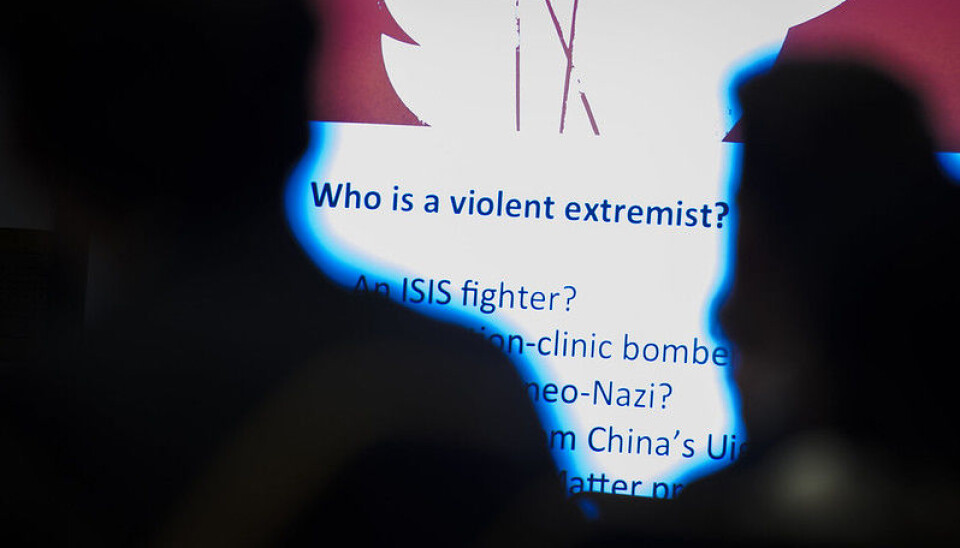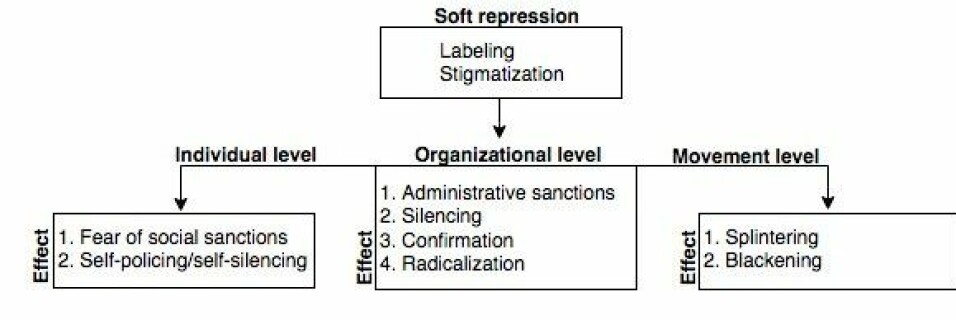
Right Now!

Being labelled as “violent extremists”: The consequences of soft repression
What are the consequences of being labeled as a “violent extremist”? How does labeling affect individual activists, their organizations, and the social movement they are part of?
Little research exists on counter-extremism efforts vis-à-vis the contemporary radical left in Western democracies.
The aim of our study has been to capture radical left activists’ perceptions of governmental measures to prevent radicalization, as well as the experienced effects of being labelled as violent extremists.
Scholars have emphasised a need to understand how protestors perceive and respond to repression, in order to understand how it affects their cognition, practices, and mobilization patterns.
To do so we interviewed 31 activists from the Swedish radical left-libertarian movement (RLLM), most of which have been active in the four organizations that were labeled as “violence-affirming extremists” by the National coordinator against violent extremism in 2015:
Antifascistisk aktion, (Anti-Fascist Action, AFA), Syndikalistiska Ungdomsförbundet (Anarcho-Syndicalist Youth Federation, SUF), Revolutionära Fronten (Revolutionary Front, RF) and Förbundet Allt åt Alla (Association Everything to Everyone, AåA).
As a basis for understanding the diverging effects of labelling, the next section presents a model that captures fundamental differences between radical social movement organizations. Thereafter, we present our main findings.
Specifying radical groups’ characteristics
The four labeled groups are all part of the same movement and are linked through collective identities, ideological affinities, joint mobilizations, and movement infrastructures.
They can all be considered radical in the sense that they strive for profound structural change and define themselves as revolutionary organizations that do not limit themselves by existing laws.
However, the four groups are also dissimilar in many respects.
By using protest event data for the year 1998-2016 (covering 3836 self-reported RLLM protests), we show that the groups have been active in different periods, that they differ in their goals, the issues they engage in and the protest tactics they employ.
Figure 1 below captures fundamental differences between the four organizations, by positioning them along three axes that can be used to differentiate radical social movement groups generally.

The horizontal axis captures the differences in protest tactics, understood as a distinction between violent and transgressive forms of protest. Because all four groups use conventional tactics (well-known and lawful tactics, such as peaceful demonstrations and handing out leaflets), the dividing line rather runs between their use of violent (unlawful actions involving property damage or violent confrontations with individuals/groups) and transgressive tactics (balances on the borders of legitimacy/illegitimacy and legality/illegality, and might include, blockades, squatting and counter-demonstrations, etc.).
The vertical axis captures the organizational form of the actor, conceptualized as the degree of openness (overt organizing) or closure (covert organizing) of an organization. The lateral axis captures the mobilizing ambition of the organization, understood as a distinction between efforts to mobilize a broader social movement (inclusiveness) versus seeking out a specific subset of activists (exclusiveness).
We argue that the impact of soft repression on radical activist groups will vary according to their placement along these three axes.
With regard to the four organizations, our protest data show that most of the activities of AFA and RF have been directed against the neo-Nazi movement. Their anti-fascist activism has been characterized by a high level of contention, also involving property damage and violent confrontations with their counterparts. The degree of openness within AFA and RF has varied over time, but their orientation towards high-risk activism has gradually contributed to more exclusive mobilization and covert forms of organizing.
Comparatively, AåA and SUF show a wider political commitment, engaging in issues such as racism and fascism, but also in, for example, labor market-, welfare- and housing issues.
Both groups seek to build a broad movement through open and inclusive forms of organizing, and their protests almost exclusively involve conventional or transgressive protest tactics.
Different consequences at different levels
In order to capture the diverging consequences of soft repression, we have developed a multi-layered analytical framework that resonates with the levels activists talked about in interviews: the individual, organizational, and movement levels.
The figure below summarizes the most prevalent effects of labeling and stigmatization and shows that this form of soft repression has different but interrelated effects at the three levels.

In our study, the labeling of certain groups as “violence-affirming extremists” primarily targets the organizational level.
The labeling has seemingly increased the stigma associated with the four groups we examined, with examples of splintering between organizations and a general blackening of the RLLM being spillover effects on the larger movement they are part of.
According to activist interviewees, the labeling and establishment of “violence-affirming extremism” as a social problem have also provided a framework through which their adversaries, as well as mass media and civil society, can evaluate and discredit the entire RLLM.
De-mobilizing effects
This said, we found the most marked consequences of soft repression at the individual level, where the risks of being associated with the extremist label seem greatest.
Several activists expressed concerns about becoming personally and publicly associated with “violent-affirming extremism”, which they fear will lead to social sanctions and limited life opportunities.
The self-policing that followed for several activists, shows that they have become more cautious to be open about their political engagement, both in private and public settings – regardless of whether they themselves use controversial tactics or not.
In turn, the accumulated processes of individual self-policing and self-silencing are likely to have negative effects on the potential to mobilize new adherents. As fewer people speak for and represent these organizations, their visibility decreases, which is likely to hinder their mobilization. Because these organizations have been among the most active in the RLLM movement, it is also likely that these obstacles to mobilization have affected the overall movement.
While the fear of social sanctions at the individual level can be seen as an indirect effect of the labeling, the experiences of administrative sanctions (e.g. denied access to public arenas or denied access to resources) and silencing (exclusion from the public discourse) at the organizational level are more direct effects. According to the interviewees, however, these latter effects are marginal and tied to specific local contexts.
Also, few of the labeled organizations enter into situations where they risk becoming the subject of administrative sanctions (e.g., by seeking funding or access to public venues). Those that have done so, either experienced few problems or found ways to get around the sanctions.
Backfire effects
In tandem with the demobilizing effects described above, our analysis also shows that “backfiring” can take place, that is, when repression makes the subjects of repression more radical or it triggers movement mobilization.
In our case, backfiring sometimes takes the form of confirmation, where the labeling creates an aura of radicalness that facilitates contacts between radicals and increases distrust of institutional politics. Previous research has shown that when activists believe that the state increasingly and unjustly police and repress their movement, militancy and clandestine activities can increase.
Also, our analysis shows how labeling itself can result in activists and organizations becoming radicalized, as the organizations more readily attract, either voluntarily or involuntarily, activists who are seeking out militant, high-risk activism.
Different consequences for different groups
The complexity of our findings reveals that activists, organizations and movements are variously affected by labeling.
When attempting to understand how labeling and stigmatization affect tactics and mobilizing patterns among the different RLLM groups, our analysis offers a multifaceted picture with partially contradictory results. The variation is due to differences in local contexts (e.g., local counter-extremism efforts, the infrastructure of local movements, etc.), as well as the nature and mobilizing ambitions of the groups themselves. With regards to the latter, the three-dimensional figure of radicalness introduced above can help us elaborate on the results.
The impact of labeling and stigmatization seems most prominent among those groups that seek to build a broad movement through open and inclusive organizing and that use conventional and transgressive forms of protests (in our case, SUF and AåA).
For these groups, perceived consequences such as blackening, splintering, administrative sanctions, silencing and concerns of social sanctions are likely to work as barriers to mobilize a wider constituency.
Among clandestine groups, who more often use violent protest tactics and mobilize covertly and exclusively, labeling seems to have no or little effect, and can even trigger backfire-effects (RF and AFA). Since these groups are already closed and mobilize selectively, they are not likely to be affected by labeling and stigmatization in the same way as organizations that try to mass mobilize. In addition, the aura of radicalness described above might help to attract the type of members that seek out clandestine, high-risk activism. Activists also spoke of how the labeling could lead to increased marginalization and isolation, which in turn might lead to further radicalization.
Based on our case study, soft repression in the form of labeling apparently failed to de-radicalize the primary target of the repressive actions, that is, the most militant groups, and, instead, hindered mobilization in those groups that engage primarily in open, inclusive and conventional forms of protest.































